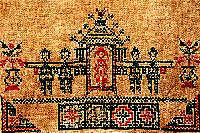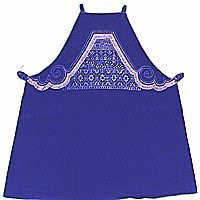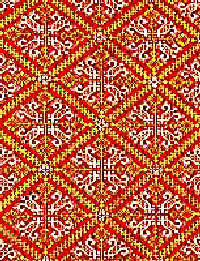 Cross-stitching, a type of embroidery, involves stitching one cross after another onto a fabric grid to form different patterns. Cross-stitched handkerchiefs and clothing accessories are unsophisticated and simple yet durable.
Cross-stitching, a type of embroidery, involves stitching one cross after another onto a fabric grid to form different patterns. Cross-stitched handkerchiefs and clothing accessories are unsophisticated and simple yet durable.
Cross-stitching is popular all across China (especially in southernShaanxi Province) and cross-stitched handicrafts are much loved by the Chinese people. Besides theHan nationality, people of many ethnic minorities in China also adore the craft, including the Dong, Miao and Qiang people.
In western China's rural areas, cross-stitching is nearly always executed with indigo blue thread on coarse, white cotton fabric. One- or two-colored embroidery made by peasants is perhaps the most striking of all, showing off its complex designs.
One of the most important and widespread functions of cross-stitching has been to adorn peasants' garments and household linen, often as a way of indicating family wealth and status in the community. Peasant embroidery is a purely domestic skill that is passed down through generations from mothers to their daughters. The stitching is simple and the fabric is readily available -- usually in the form of woven linen or cotton. Although thread colors are often limited to just two or three types, they are beautifully dyed and often accentuated by dark brown or black outlines.
often limited to just two or three types, they are beautifully dyed and often accentuated by dark brown or black outlines.
 Origin and spread
Origin and spread
From historical and archaeological evidence, there is not yet enough accurate information to trace the exact origins of cross-stitched embroidery. Some historians, however, suggest that the development of cross-stitching is greatly owed to the craftsmanship of the Chinese since this type of embroidery is known to have flourished during theTang Dynasty(618-907) and a strong rural tradition of cross stitching still existed in the area during the early 20th century.
